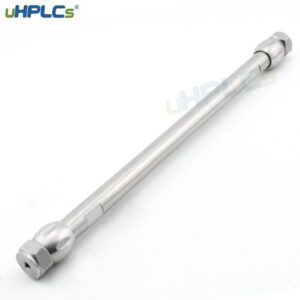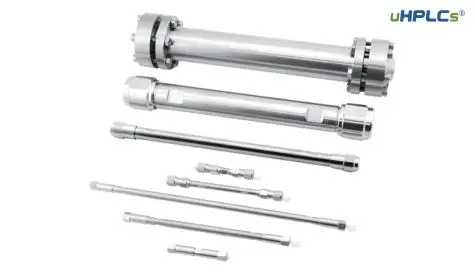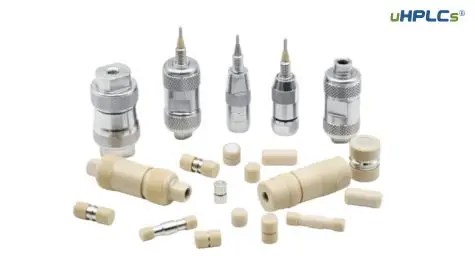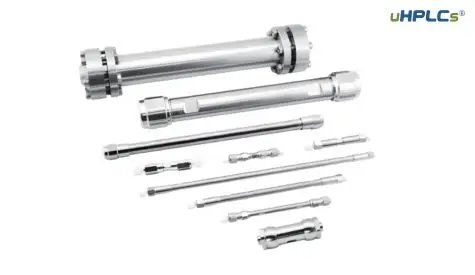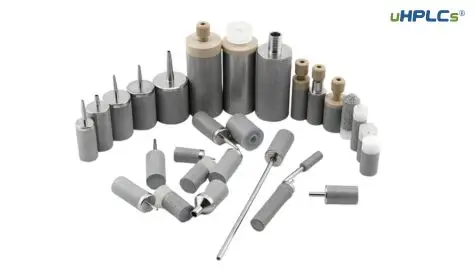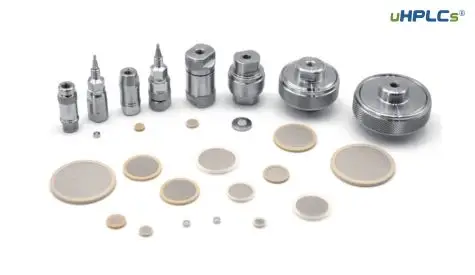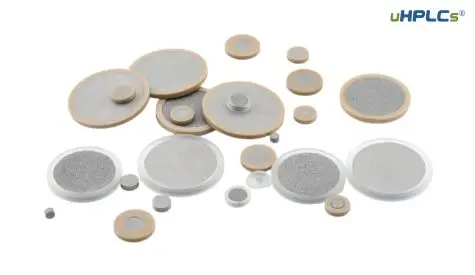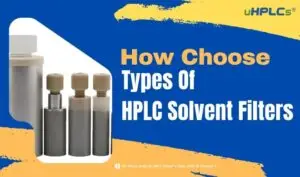Types of Columns Used in HPLC
Introduction
High-performance liquid chromatography (HPLC) is a technique that is used to separate and quantify the components of a mixture. It does this by using a column that is packed with a stationary phase. The stationary phase can be a variety of different materials, such as silica gel, alumina, or polymer. The mobile phase is a liquid that is pumped through the column. The components of the mixture interact with the stationary phase and the mobile phase to different degrees, which causes them to separate.
The type of column that is used in HPLC depends on the specific application. There are four main types of HPLC columns:
- Normal phase columns
- Reverse phase columns
- Ion exchange columns
- Size exclusion columns
Normal Phase Columns
Normal phase columns are the most common type of HPLC column. They are used to separate compounds based on their polarity. Polar compounds interact more strongly with the stationary phase, while non-polar compounds interact more strongly with the mobile phase. This causes the polar compounds to elute from the column more slowly than the non-polar compounds.
Normal phase columns are typically packed with silica gel, which is a polar material. The mobile phase is a non-polar solvent, such as hexane or heptane.
Here are some of the advantages and disadvantages of using normal phase columns:
Advantages:
- Very versatile; can be used to separate a wide range of compounds
- High resolution
- Good selectivity
Disadvantages:
- Can be difficult to use; requires careful control of the mobile phase composition and pH
- Susceptible to column fouling
- Not as compatible with aqueous mobile phases as reverse phase columns
Normal phase columns are often used in the following applications:
- Separation of non-polar compounds, such as lipids and hydrocarbons
- Separation of enantiomers
- Preparative HPLC
Here are some examples of normal phase columns:
- Silica gel columns
- Cyano columns
- Amino columns
- Diol columns
When choosing a normal phase column, it is important to consider the following factors:
- The polarity of the compounds to be separated
- The desired resolution and selectivity
- The compatibility of the column with the mobile phase to be used
- The cost of the column
2. Reverse Phase Columns
Reverse phase columns are the opposite of normal phase columns. They are used to separate compounds based on their non-polarity. Non-polar compounds interact more strongly with the stationary phase, while polar compounds interact more strongly with the mobile phase. This causes the non-polar compounds to elute from the column more slowly than the polar compounds.
Reverse phase columns are typically packed with a bonded phase, such as C18 or C8. The bonded phase is a non-polar material that is attached to the silica gel particles. The mobile phase is a polar solvent, such as water or acetonitrile.
Here are some of the advantages and disadvantages of using reverse phase columns:
Advantages:
- Easy to use; do not require careful control of the mobile phase composition and pH
- Compatible with aqueous mobile phases
- Robust and durable
Disadvantages:
- Not as versatile as normal phase columns; cannot be used to separate all types of compounds
- Lower resolution and selectivity than normal phase columns
Reverse phase columns are often used in the following applications:
- Separation of polar compounds, such as drugs and pharmaceuticals
- Separation of proteins and peptides
- Analytical HPLC
Here are some examples of reverse phase columns:
- C18 columns
- C8 columns
- C4 columns
- Phenyl columns
When choosing a reverse phase column, it is important to consider the following factors:
- The polarity of the compounds to be separated
- The desired resolution and selectivity
- The compatibility of the column with the mobile phase to be used
- The cost of the column
If you are unsure which reverse phase column to choose, it is best to consult with a HPLC expert.
Here is a table comparing normal phase and reverse phase columns:
| Property | Normal Phase Columns | Reverse Phase Columns |
|---|---|---|
| Polarity of stationary phase | Polar | Non-polar |
| Polarity of mobile phase | Non-polar | Polar |
| Separation mechanism | Polarity | Non-polarity |
| Advantages | Versatile, high resolution, good selectivity | Easy to use, compatible with aqueous mobile phases, robust and durable |
| Disadvantages | Difficult to use, susceptible to column fouling, not as compatible with aqueous mobile phases | Not as versatile, lower resolution and selectivity |
| Common applications | Separation of non-polar compounds, enantiomers, preparative HPLC | Separation of polar compounds, proteins and peptides, analytical HPLC |
| Examples of columns | Silica gel, cyano, amino, diol | C18, C8, C4, phenyl |
Hope this information is helpful. Please let me know if you have any other questions.
Ion Exchange Columns
Ion exchange columns are used to separate compounds based on their charge. The stationary phase is a charged material, such as a cation exchange resin or an anion exchange resin. The mobile phase is a buffer solution that contains ions of the opposite charge to the stationary phase.
Cation exchange columns are used to separate positively charged ions, such as sodium and potassium. Anion exchange columns are used to separate negatively charged ions, such as chloride and sulfate.
Here are some of the advantages and disadvantages of using ion exchange columns:
Advantages:
- High selectivity for charged compounds
- Can be used to separate compounds that are difficult to separate by other methods
- Can be used to purify compounds
Disadvantages:
- Limited versatility; can only be used to separate charged compounds
- Can be difficult to use; requires careful control of the mobile phase composition and pH
- Susceptible to column fouling
Ion exchange columns are often used in the following applications:
- Separation of metal ions
- Separation of organic ions
- Purification of proteins and other biomolecules
- Water treatment
Here are some examples of ion exchange columns:
- Cation exchange columns (strong acid, weak acid, strong base, weak base)
- Anion exchange columns (strong base, weak base, strong acid, weak acid)
When choosing an ion exchange column, it is important to consider the following factors:
- The charge of the compounds to be separated
- The desired resolution and selectivity
- The compatibility of the column with the mobile phase to be used
- The cost of the column
If you are unsure which ion exchange column to choose, it is best to consult with a HPLC expert.
Here is a table comparing ion exchange columns to normal phase and reverse phase columns:
| Property | Ion Exchange Columns | Normal Phase Columns | Reverse Phase Columns |
|---|---|---|---|
| Stationary phase | Charged material | Silica gel | Bonded phase |
| Mobile phase | Buffer solution | Non-polar solvent | Polar solvent |
| Separation mechanism | Charge | Polarity | Non-polarity |
| Advantages | High selectivity for charged compounds | Versatile, high resolution, good selectivity | Easy to use, compatible with aqueous mobile phases, robust and durable |
| Disadvantages | Limited versatility; can only be used to separate charged compounds; difficult to use; susceptible to column fouling | Difficult to use; susceptible to column fouling; not as compatible with aqueous mobile phases | Not as versatile, lower resolution and selectivity |
| Common applications | Separation of metal ions, organic ions, purification of proteins and biomolecules, water treatment | Separation of non-polar compounds, enantiomers, preparative HPLC | Separation of polar compounds, proteins and peptides, analytical HPLC |
| Examples of columns | Cation exchange, anion exchange | Silica gel, cyano, amino, diol | C18, C8, C4, phenyl |
Size exclusion columns
Size exclusion columns are used to separate compounds based on their size. The stationary phase is a porous material, such as silica gel or agarose. The pores in the stationary phase are of different sizes. Large molecules are excluded from the pores, so they elute from the column first. Small molecules can enter the pores, so they elute from the column last.
Size exclusion columns are often used to separate proteins and other macromolecules.
Here are some of the advantages and disadvantages of using size exclusion columns:
Advantages:
- Very gentle on biological samples
- Can be used to separate compounds of a wide range of sizes
- High resolution and selectivity
Disadvantages:
- Not as versatile as other types of HPLC columns; cannot be used to separate all types of compounds
- Requires careful control of the mobile phase composition and pH
- Susceptible to column fouling
Size exclusion columns are often used in the following applications:
- Separation of proteins and other macromolecules
- Determination of molecular weight
- Analysis of protein aggregates
- Purification of proteins and other biomolecules
Here are some examples of size exclusion columns:
- Silica gel columns
- Agarose columns
- Dextran columns
When choosing a size exclusion column, it is important to consider the following factors:
- The size of the compounds to be separated
- The desired resolution and selectivity
- The compatibility of the column with the mobile phase to be used
- The cost of the column
If you are unsure which size exclusion column to choose, it is best to consult with a HPLC expert.
Here is a table comparing size exclusion columns to normal phase, reverse phase, and ion exchange columns:
| Property | Size Exclusion Columns | Normal Phase Columns | Reverse Phase Columns | Ion Exchange Columns |
|---|---|---|---|---|
| Stationary phase | Porous material | Silica gel | Bonded phase | Charged material |
| Mobile phase | Aqueous or non-aqueous solvent | Non-polar solvent | Polar solvent | Buffer solution |
| Separation mechanism | Size | Polarity | Non-polarity | Charge |
| Advantages | Gentle on biological samples, wide range of sizes, high resolution and selectivity | Versatile, high resolution, good selectivity | Easy to use, compatible with aqueous mobile phases, robust and durable | High selectivity for charged compounds |
| Disadvantages | Not as versatile, requires careful control of mobile phase, susceptible to fouling | Difficult to use, susceptible to fouling, not as compatible with aqueous mobile phases | Not as versatile, lower resolution and selectivity | Limited versatility, difficult to use, susceptible to fouling |
| Common applications | Separation of proteins and other macromolecules, molecular weight determination, analysis of protein aggregates, purification of proteins and other biomolecules | Separation of non-polar compounds, enantiomers, preparative HPLC | Separation of polar compounds, proteins and peptides, analytical HPLC | Separation of metal ions, organic ions, purification of proteins and biomolecules, water treatment |
| Examples of columns | Silica gel, agarose, dextran | Silica gel, cyano, amino, diol | C18, C8, C4, phenyl | Cation exchange, anion exchange |
Conclusion
The four main types of HPLC columns are normal phase columns, reverse phase columns, ion exchange columns, and size exclusion columns. Each type of column has its own advantages and disadvantages, and is suitable for different applications.
Normal phase columns are the most versatile type of HPLC column, but they can be difficult to use. They are often used to separate non-polar compounds, enantiomers, and for preparative HPLC.
Reverse phase columns are easy to use and are compatible with aqueous mobile phases. They are often used to separate polar compounds, proteins and peptides, and for analytical HPLC.
Ion exchange columns are highly selective for charged compounds, but they are not as versatile as normal phase or reverse phase columns. They are often used to separate metal ions, organic ions, purify proteins and other biomolecules, and for water treatment.
Size exclusion columns are very gentle on biological samples and can be used to separate compounds of a wide range of sizes. They are often used to separate proteins and other macromolecules, determine molecular weight, analyze protein aggregates, and purify proteins and other biomolecules.
When choosing an HPLC column, it is important to consider the type of compounds to be separated, the desired resolution and selectivity, the compatibility of the column with the mobile phase to be used, and the cost of the column. It is also important to consult with a HPLC expert to ensure that you choose the right column for your application.
OEM HPLC Column to Work with uHPLCs
uHPLs is a professional HPLC empty column OEM manufacturer that can produce the four main types of HPLC columns (normal phase, reverse phase, ion exchange, and size exclusion columns), as well as OEM special HPLC columns with your brand.
Here is a description of their capabilities:
- High quality: uHPLs has strict quality control procedures in place to ensure that their columns meet the highest standards. They use high-purity materials and state-of-the-art manufacturing equipment to produce columns that deliver consistent performance and long service life.
- Wide range of products: uHPLs offers a wide range of HPLC columns to meet the needs of a variety of applications. They can produce columns with different dimensions, particle sizes, and stationary phases. They can also produce custom columns to meet your specific requirements.
- OEM capabilities: uHPLs can OEM special HPLC columns with your brand. They can print your logo and branding on the columns and packaging. This can help you to build your brand and increase your market share.
If you are looking for a high-quality, reliable, and affordable HPLC column OEM manufacturer, then uHPLs is a great option. They can provide you with the columns you need to meet your specific application requirements and help you to succeed in your business.
Here are some of the benefits of working with uHPLs:
- High quality: uHPLs is committed to providing its customers with the highest quality HPLC columns. They use high-purity materials and state-of-the-art manufacturing equipment to produce columns that deliver consistent performance and long service life.
- Competitive prices: uHPLs offers its columns at competitive prices. This is because they are a direct manufacturer and do not have to pay markups to distributors.
- Fast delivery: uHPLs can ship your columns quickly and efficiently. They have a large inventory of columns in stock and can ship most orders within 24 hours.
- Excellent customer service: uHPLs is committed to providing its customers with excellent customer service. They have a team of experienced engineers who can answer your questions and help you to choose the right columns for your application.
If you are interested in learning more about uHPLs’ HPLC column OEM services, please visit their website or contact them directly.


